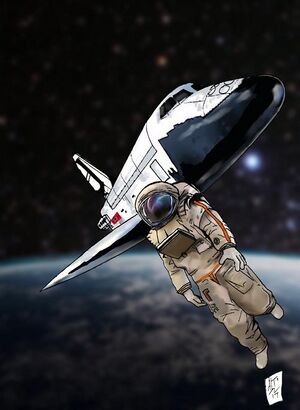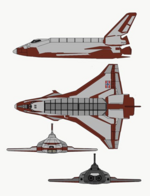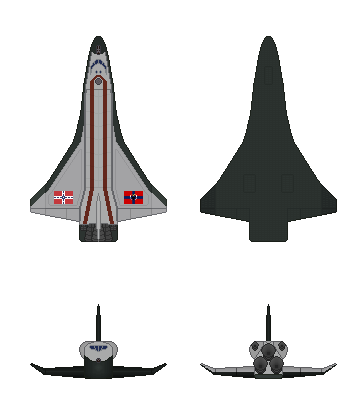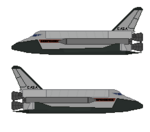Space Program of Anagonia: Difference between revisions
| Line 117: | Line 117: | ||
==The Jupiter II Rusable Rocket== | ==The Jupiter II Rusable Rocket== | ||
By the year 75 AUR, CASA was heavily reliant on expendable launch vehicles such as the Ariane 5, Atlas V, and Delta IV Heavy for its satellite deployment needs. However, the recurring expenses associated with these non-reusable rockets, including substantial royalty fees paid to corporations, posed significant financial burdens on the space program. Recognizing the need for a more cost-effective and sustainable solution, CASA Chief Administrator Jason Pickman initiated the Future Reusable Launch Rocket Initiative (FRLRI) in collaboration with the Confederate States Military, given the vital role of launch rockets in the satellite defense network. | |||
Affectionately dubbed "the firefly project" by its participants, FRLRI aimed to develop reusable launch systems capable of reducing costs and improving efficiency. Under the leadership of Colonel Bailey Brown from the Confederate States Air Force, the initiative drew inspiration from private industry space programs and existing launch technologies. The Jupiter I concept rocket emerged from this endeavor, combining elements from various designs to create an innovative and promising prototype. | |||
In 78 AUR, the first test-flight of the Jupiter I prototype took place but ended in a catastrophic explosion due to structural integrity issues stemming from the diverse array of components utilized. Despite the setback, the Military persisted, ordering the construction of two additional prototypes against CASA's objections. Colonel Brown, recognizing the risks, sought assistance from Chief Administrator Jason Pickman to address safety concerns and procedural challenges. Following a period of internal dispute and negotiation, Colonel Brown assumed command of the project and collaborated closely with CASA to redesign and salvage the final Jupiter I prototype. | |||
The resulting redesign, designated as the Jupiter I-A, saw improvements in launch procedures and system integrity. Although the launch was met with partial success, with the first stage failing to land as planned and the second stage failing to achieve a full orbit, it marked a significant step forward in the development process. Subsequent prototypes faced similar challenges, prompting Colonel Brown and CASA designers to refine their approach, ultimately leading to the birth of the Jupiter II concept rocket. | |||
==The Independence-class Space Shuttle== | ==The Independence-class Space Shuttle== | ||
Revision as of 19:41, 18 May 2024
This article is incomplete because it is pending further input from participants, or it is a work-in-progress by one author. Please comment on this article's talk page to share your input, comments and questions. Note: To contribute to this article, you may need to seek help from the author(s) of this page. |
Overview
The Confederate Aeronautics and Space Administration (CASA) stands as the pinnacle of space exploration for the Confederate States of Anagonia (CSA). Its inception in 1951 CE under the directive of President William Youngston marked the dawn of Anagonian space ambitions. Initially founded with a military focus, CASA has since transformed into a multifaceted organization, blending military prowess with civilian innovation. Today, CASA's mandate extends beyond national defense to encompass a broad spectrum of scientific research, technological advancement, and international collaboration. With a legacy of groundbreaking achievements and a vision for the future, CASA remains at the forefront of Anagonia's journey into the cosmos.
History
Founding and Early Years (1951 - 1960s)
CASA was founded in 1951 CE to fulfill the Confederate States Air Force's ambitions of launching suborbital and orbital assets. Initially, the agency's focus was predominantly military, facilitating the launch of reconnaissance and early communication satellites. President William Youngston (1951 - 1956 CE) and his successor, President Travis Johnathan (1956 - 1961 CE), maintained this military orientation, with CASA being entirely government-funded.
Transition to Civilian Orientation (1961 - 1980s)
The turning point for CASA came with the election of President Laurel Alexander (1961 - 1966 CE). President Alexander envisioned the space agency pushing the limits of technology, which was very primitive at the time, akin to the early Apollo era. In 1962 CE, he refocused CASA to introduce a joint civilian-military mission directive. Under his leadership, CASA began to rebuild and restructure its orbital launch rockets, which were similar to the Redstone or Titan II rockets of that era, to support manned missions into orbit.
International Collaboration and Early Achievements (1963 - 1967)
In 1963 CE, CASA achieved a significant milestone when Astronaut Colonel Hughes Jackton became the first Anagonian in space. Colonel Jackton, a member of the Confederate States Air Force (CSAF), had been a long-time participant in the CASA space program. His successful mission captured global attention and led to international collaboration. In the same year, the USSR of Nodea Rudav and the Imperial Drekamythian Empire expressed interest in participating in CASA's missions. This bolstered CASA's ranks with not only Anagonian Astronauts but also Cosmonauts from Nodea Rudav and Drekanuats from Drekamythia.
In 1965 CE, CASA launched its first three-person mission in orbit using a Modified Titan II rocket with a modified Gemini crew capsule. The crew consisted of Anagonian Astronaut Colonel Hughes Jackton as Commander, Rudavian Major Cosmonaut Larionov Leonidovich as Communications Officer, and Drekamythian Drekanaut Captain Arruns Latinius as Spacecraft Specialist. This mission marked a significant victory for Anagonia and showcased successful international cooperation and teamwork.
The Big Gemini Program and Continental Space Station (1965 - 1967)
Between 1965 and 1966 CE, CASA, alongside its international partners in Nodea Rudav and Drekamythia, developed and constructed the Big Gemini concept craft to safely carry personnel into and from space. To launch the Big G, as it was known, CASA developed the Titan III family of rockets. Plans for a space station were also developed and implemented. Using Titan III launches, CASA put into orbit components constructed from empty Titan II upper stages, culminating in the completion of the Continental Space Station. This primitive, three-chambered space station was designed for early understanding of space habitation and operations.
Three Big Gemini launches between 1966 and 1967 supported the space station. However, by late 1967, the Continental Space Station had drifted too far from a safe orbit and was allowed to burn up in the Esvanovian atmosphere, crashing safely into the Anagonian Ocean.
Lunar Missions and the Apollo Program (1966 - 1968)
During the Big Gemini collaboration, CASA pursued its objective set by President Laurel Alexander to land an Anagonian on the Moon. As the Gemini program gained popularity, CASA, in collaboration with the CSAF, developed the Saturn I rocket in 1966 CE. The Saturn I rocket was extensively tested and used to launch the first series of Apollo command modules, paving the way for future manned orbital flights.
By 1967, CASA, under the direction of President Forest Holloway (1966 - 1979 CE), and its international partners had developed the Saturn V concept rocket. The Apollo Command/Service Module (CSM) quickly evolved from a Block I concept into Block II and Block III productions. Block II was intended for orbital missions, while Block III, designed for long-duration missions, was complemented by an Orbital Mission Module (OMM), which provided additional living and working space, replacing the Lunar Excursion Module (LEM).
In early 1968, the Apollo 4 mission launched using the Block III concept and an OMM module instead of an LEM. The crew included Anagonian Astronaut Colonel Hughes Jackton as Commander, Rudavian Cosmonaut Captain Bershova Vladislavovna as Spacecraft Specialist (the second female in space and the first female to reach lunar orbit), and Drekamythian Drekanaut Lieutenant Titus Fuscus as Communications Officer. After three days, three hours, and 49 minutes, the crew successfully arrived at lunar orbit, spent three days conducting research and cultural activities, and then safely returned home.
Two months later, Apollo 5 was prepared on the launchpad. It was a standard Block II variant with an LEM module for lunar landings instead of an OMM module. The crew for Apollo 5 included Anagonian Astronaut Major Logan Murray as Commander (trained by Hughes Jackton), Drekamythian Drekanaut Captain Faleria Geminiana as Spacecraft Specialist (the second female to reach lunar orbit), and Rudavian Cosmonaut Turbina Stanislavovna as Communications Specialist (the first female to land on the Moon).
After 75 hours and 49 minutes, Apollo 5 achieved lunar orbit and detached its LEM module. Captain Faleria Geminiana stayed behind in the CSM while Cosmonaut Turbina Stanislavovna and Major Logan Murray descended to the lunar surface. Despite a main engine failure mid-burn, Major Murray's quick thinking to switch to backup pumps saved the LEM from a crash. They successfully landed in Mare Cognitum, spent two days on the lunar surface, and then safely reunited with the CSM and returned home.
Apollo 5 left behind a golden memorial plaque with the following inscription: "On this Lunar Soil does Apollo 5, a joint mission between three international neighbors, brothers, and nations, land on the surface of this Moon in 1968 Common Era. We land in peace in hopes that these first steps shall cement within us a permanent unity that shall be forever unshaken, a peace forever unbroken, and a drive for betterment forever kept and never lost."
Post Moon Landing Era (1969 - 1975)
Following the success of the first moon landing, President Holloway authorized several more lunar missions. Apollos 6 through 24 were implemented, with only two missions not successfully landing on the Moon. Apollo 14 experienced issues with its LEM module, similar to Apollo 5, and was unable to land. Instead, it conducted successful orbital reconnaissance for Apollo 15, which benefited from the fixes implemented after Apollo 14's issues.
In 1972 CE, Apollo 18 faced a tragic incident. The mission's Commander, Rudavian Cosmonaut Major Shirokov Anatolievich, died heroically during a spacewalk to repair a damaged oxygen line caused by a catastrophic explosion in the mixing tanks. Despite the successful repair, his tether snapped, and he was lost to space. Major Anatolievich managed to say his goodbyes to his family, facilitated by CASA Mission Control, before he asphyxiated. His sacrifice saved the rest of the crew and secured his legacy as a hero in Nodea Rudav and CASA.
Following this tragedy, President Holloway ordered a temporary hold on CASA's operations for six months in 1972 to 1973, mandating a thorough review and correction of the Apollo program's issues. Public confidence was severely shaken, and CASA's Chief Administrator was replaced due to public pressure. Hughes Jackton, retired at the time, was brought back to lead the agency through this crisis.
Under Jackton's leadership, CASA focused on fixing and retrofitting existing Apollo mission parts. By mid-1973, Saturn rockets were once again launched, and Jackton laid plans for a new space station using parts from the Saturn IC era. The Apollo program concluded with Apollo 22 in 1975, and in 1976, Apollo 23 launched the Skylab space station. Apollos 24 and 25 maintained and expanded Skylab, preparing it for a dormant period with corrections learned from the Continental Space Station.
The Space Shuttle Era (1976 - 1981)
In mid-1976, CASA unveiled the CASA-S-00 Anatolievich, the first iteration of the Orbiter Space Shuttle, named in honor of Cosmonaut Major Shirokov Anatolievich. This test-bed craft was used throughout 1976 and 1977 to gather necessary data, and it was retired in late 1977, gifted to Nodea Rudav for permanent display in a museum. Nodea Rudav used this data to develop its Buran model of orbiters.
Following the test model, CASA constructed three Orbiter-class Space Shuttles: the CASA-S-01 Plymouth, CASA-S-02 Imperius, and CASA-S-03 Vigilance. The Plymouth reestablished contact with Skylab, renamed Space Station Apollo in 1978 and reclassified as a research station. It was expanded using leftover Saturn V parts retrofitted into space station compartments.
President Holloway passed away in late 1979, having seen his goals for CASA fulfilled. Hughes Jackton also resigned at 77, succeeded by Chief Administrator Bershova Vladislavovna, the first female to reach lunar orbit. During her tenure, CASA added several more shuttles to its fleet, including the CASA-S-04 Enterprise, CASA-S-05 Anagonia, CASA-S-06 Excalibur, and CASA-S-07 Trinity.
President Christine Kent succeeded Holloway and served until 1981 CE, working closely with Chief Administrator Vladislavovna to support CASA's needs. During this period, Nodea Rudav developed and produced the Buran-shuttle concept, adding the CASA-B-01 Reliance and CASA-B-02 Typhoon to CASA's fleet in mid-1978. By late 1979, additional Buran shuttles, CASA-B-03 Serenity, CASA-B-04 Tsunami, and CASA-B-05 Blizzard, were integrated into CASA operations.
Between 1980 and 1981 CE, CASA invested in private industry rockets such as the Delta Rocket and Trident I, while continuing to use Titan III rockets.
The Space Station Era (1981 - 1985)
With President Rudolf Jarod Hart's election in 1981 CE, CASA embarked on a new era of space exploration. Under Chief Administrator Vladislavovna's leadership, CASA received a fresh Presidential Directive: Expand into Space. Recognizing the importance of understanding the implications of permanent habitation in space, CASA initiated an ambitious project to revitalize and modernize Space Station Apollo. Leveraging the capabilities of CASA's Orbiter and Buran shuttles, the retrofitting of the station was completed by 1985. Concurrently, construction began on Space Station Confederation, a testament to CASA's commitment to pushing the boundaries of space exploration.
Expansion into Space (1985 - 1990)
President Amalia Sutton, who assumed office in 1986 CE, embraced the vision of her predecessors to expand CASA's presence in space. Launching a series of ambitious initiatives, CASA propelled space probes deeper into the Esvanovian solar system while nearing the completion of Space Station Confederation. By 1988, the station was fully operational, orbiting above Space Station Apollo. Together, these stations ushered in a new era of exploration, facilitating CASA's endeavors to unravel the mysteries of the cosmos and pave the way for sustained human presence in space.
The Dormant Years (1991 - 1996)
The presidency of Darrell Farmer, beginning in 1991 CE, marked a period of relative stagnation for CASA. Focused solely on maintaining orbital ambitions, Farmer shelved plans for a lunar base despite announcements of ambitious lunar missions. Between 1991 and 1996, CASA's achievements were limited to satellite launches, probes, and sporadic shuttle missions, reflecting a subdued period in the agency's history.
The Resurgence (1996 - 2000)
Following Farmer's departure from office and Chief Administrator Vladislavovna's retirement in 1996, CASA underwent a revitalization. President Von Huey Cunningham appointed Lara Williamson as Chief Administrator, drawing upon her extensive experience within CASA as an engineer. Under Williamson's leadership, CASA embarked on a comprehensive modernization effort, revamping its electronics, infrastructure, manufacturing processes, and administrative practices, heralding a new era of innovation and progress for the agency.
One significant challenge facing CASA was the outdated and costly expendable launch vehicles used for missions. In response, Chief Administrator Williamson initiated the Future Reusable Launch Rocket Initiative (FRLRI) in 1996. Recognizing the importance of launch rockets for the Confederate States Military's satellite defense network, the initiative received substantial subsidies from the military.
In 1999, CASA unveiled the prototype of the Jupiter I reusable launch rocket, marking a milestone in the FRLRI. Led by Colonel Baily Brown and Administrator Jason Pickman, the Jupiter I trials initially encountered setbacks but evolved into partial success with the modified Jupiter I-A variant. Despite its improved performance, the craft awaited final approval for operational deployment.
Development on the Jupiter II, the successor to the Jupiter I, commenced in 1999, with completion anticipated by 2003.
The Modern Era (2000s-Onward)
The transition from President Cunningham's administration to President Valentine Shields marked a significant period of growth and advancement for CASA. Building upon the reforms initiated under Cunningham's tenure, CASA experienced exponential progress, propelled by a collaborative effort with the Federal Spatial Advancement Administration (FSAA). Notably, Anagonian Astronaut Major Andrew Booth (CSAF) participated in the Marina Program's Marina 12 mission, marking a historic return of Anagonians to the lunar surface.
The Future Reusable Launch Rocket Initiative (FRLRI) achieved success and completion on April 11th, 2003 CE, following the successful trials of the Jupiter II prototype. Subsequent launches validated its reusability and efficiency. In 2004, CASA and the Military approved it for launches and full-scale production after two successful satellite launches. Following the success of the Unmanned Jupiter II, CASA developed a manned variant with a LEM module.
Under the leadership of Chief Administrator Lara Williamson, CASA undertook a comprehensive retrofitting initiative for its Orbiter and Buran Shuttle Fleet, completing the project in 2005 CE. Subsequently, the refurbished shuttle fleet played a pivotal role in modernizing Space Stations Apollo and Confederation, bringing them up to contemporary standards by 2011 CE.
In 2011, CASA launched the Future Shuttle Initiative (FSI), also known as the Future Shuttle Program (FSP). Initially encountering setbacks with a failed prototype, the FSI Program pivoted to modernize the existing Buran shuttles in CASA's inventory. This effort led to the development of the Buran II-class of space shuttles, incorporating advancements from both the Buran and Orbiter class shuttles. The Independence-class Space Shuttle, a product of the FSI, was introduced in August 2016 CE, boasting Anagonian-made, developed, and manufactured components. CASA's primary space shuttles—CASA-I-01 Independence, CASA-I-02 Freedom, CASA-I-03 Liberty, and CASA-I-04 Pathfinder—represented a new era of space exploration for Anagonia.
By 2017, CASA had retired the majority of its Orbiter shuttle fleet to museums, retaining only CASA-S-04 Enterprise and CASA-S-05 Anagonia due to their modernizations. Similarly, the remaining Buran shuttles not upgraded to Buran II-class were also retired to museums.
In response to a petition from the Anagonian Military in 2012, President Vito Boone (2006 - 2016) approved the construction of Space Station Viper, a dedicated military outpost in low Earth orbit. Completed by 2014 CE, Space Station Viper serves as a crucial asset for Anagonia's defense and security operations.
Simultaneously, Space Station Discovery began construction in 2013 CE, reaching its final assembly in 2022 CE. Positioned in high Earth orbit, Space Station Discovery stands as Anagonia's most advanced and internationally renowned space station, facilitating cutting-edge research and exploration endeavors.
However, tragedy struck in 2014 CE when CASA-S-03 Vigilance, docked to Space Station Apollo in low Earth orbit, was rocked by a violent explosion. The catastrophic event resulted in the destruction of both the shuttle and the space station, sending debris raining down across Minor Kistavich. Investigations revealed that a terrorist group had planted a bomb disguised as a micro-satellite package on Vigilance, prompting CASA to implement stringent security measures in response.
In 2015, CASA constructed its first permanent base on the moon: Outpost Sierra. A mining base for materials, it initially was met with significant setbacks. However after reconfiguring the base and delivering new components, it quickly became profitable.
In 2020 CE, Chief Administrator Lara Williamson retired from her esteemed position, passing the torch to Marissa Schultz, who assumed leadership of CASA. As Schultz took the helm, CASA entered a new era, poised to continue its legacy of innovation and exploration in the ever-expanding frontier of space.
The Jupiter II Rusable Rocket
By the year 75 AUR, CASA was heavily reliant on expendable launch vehicles such as the Ariane 5, Atlas V, and Delta IV Heavy for its satellite deployment needs. However, the recurring expenses associated with these non-reusable rockets, including substantial royalty fees paid to corporations, posed significant financial burdens on the space program. Recognizing the need for a more cost-effective and sustainable solution, CASA Chief Administrator Jason Pickman initiated the Future Reusable Launch Rocket Initiative (FRLRI) in collaboration with the Confederate States Military, given the vital role of launch rockets in the satellite defense network.
Affectionately dubbed "the firefly project" by its participants, FRLRI aimed to develop reusable launch systems capable of reducing costs and improving efficiency. Under the leadership of Colonel Bailey Brown from the Confederate States Air Force, the initiative drew inspiration from private industry space programs and existing launch technologies. The Jupiter I concept rocket emerged from this endeavor, combining elements from various designs to create an innovative and promising prototype.
In 78 AUR, the first test-flight of the Jupiter I prototype took place but ended in a catastrophic explosion due to structural integrity issues stemming from the diverse array of components utilized. Despite the setback, the Military persisted, ordering the construction of two additional prototypes against CASA's objections. Colonel Brown, recognizing the risks, sought assistance from Chief Administrator Jason Pickman to address safety concerns and procedural challenges. Following a period of internal dispute and negotiation, Colonel Brown assumed command of the project and collaborated closely with CASA to redesign and salvage the final Jupiter I prototype.
The resulting redesign, designated as the Jupiter I-A, saw improvements in launch procedures and system integrity. Although the launch was met with partial success, with the first stage failing to land as planned and the second stage failing to achieve a full orbit, it marked a significant step forward in the development process. Subsequent prototypes faced similar challenges, prompting Colonel Brown and CASA designers to refine their approach, ultimately leading to the birth of the Jupiter II concept rocket.
The Independence-class Space Shuttle
Development of the Independence-class Space Shuttle
The Independence-class space shuttle emerged from CASA's imperative to modernize its aging shuttle fleet, comprising both the Orbiter-class from CASA and the Buran-class from the Nodea Rudav CCCP. Instead of investing billions into refurbishing these shuttles, CASA opted to develop a homegrown alternative to secure the future of its space program. In 2011 CE, Anagonia assembled its top minds to conceive a shuttle with the carrying capacity of the Orbiter and the technological prowess of the Buran-class. Over five years, under the Future Shuttle Initiative (FSI), or Future Shuttle Program (FSP), numerous concept renditions were explored, yielding two promising designs: the Buran-II and the Independence-X.
The Buran-II proposal aimed to enhance existing Buran shuttles with advanced automated systems. Two prototypes, CASA-B-04 Tsunami and CASA-B-05 Blizzard, were modified to showcase the proposed upgrades. Despite initial trials, the Buran-II shuttles fell short of expectations, leading to their retirement after several test launches. However, their modernizations paved the way for the continued use of Tsunami and Blizzard in CASA's fleet.
In contrast, the Independence-X initiative represented a bold departure from conventional shuttle designs. Inspired by the Buran and the Orbiter's cargo capacity, designers sought to create a fully Anagonian variant. Despite concerns during initial testing, a prototype, the FSI-X Independence-X, was constructed and demonstrated impressive capabilities. Though a subsequent unmanned launch exposed reentry issues, the automated systems salvaged the mission, underscoring the prototype's potential.
To address the shortcomings identified during testing and meet FSP standards, designers from both projects collaborated. After two more years of intensive work, the joint team unveiled the Independence-class Space Shuttle and Sovereignty Launch Vehicle. Extensive research and testing ensured compliance with FSP criteria, culminating in the rollout of the CASA-I-01 Independence prototype on August 7th, 95 AUR.
The Independence-class shuttle integrated proven features of the Buran and Orbiter, including an elongated nose for additional systems and crew compartments. Notable enhancements included extended cargo capacity, detachable boosters for lunar missions, and advanced mechanical and electronic systems. Safety measures, such as detachable crew sections for emergencies, further underscored CASA's commitment to crew welfare.
The Sovereignty Launch Vehicle, designed for 100% reusability, featured booster parachutes and self-landing capabilities. Though initial proposals suggested ground landings, CASA opted for water landings to ensure safety.
On February 14th, 2022, the CASA-I-01 Independence and Sovereignty Launch Vehicle embarked on their inaugural flight. Following successful aerial trials, the Independence's unmanned test flight validated its systems, while the Sovereignty demonstrated flawless performance, culminating in a safe water landing.
Subsequent crewed missions, Independence Two and Independence Three, confirmed the shuttle's capabilities, leading to full-scale production. The original prototype, CASA-I-01 Independence, underwent retrofitting for active service, cementing the Independence-class as a cornerstone of CASA's space program.
Typical Functions
The CASA Independence-class Space Shuttle was designed to take over and fulfill a variety of functions that are shared by both the CASA Orbiter and Nodea Rudav CCCP Buran orbiter variants. Those functions and operations include cargo ferrying to orbit, deployment of contracted private industry and government assets, deployment of additional space station modules and space station maintenance, covert special military operations with applicable equipment installed in cargo bay, CASA crew transport to and from operational space stations, crew and cargo transport to Lunar facilities from orbit, and a variety of other functions that serve the interests of both CASA and the Confederate States.
Special Functions
Due to the specialized nature of the Independence-class Space Shuttle, experimental system designs can be installed to further understand and push the boundaries of modern science and technology. Traditionally, however, the shuttle itself is intended ferry a specific module or probe to orbit that has these specified designs installed and will act as mothership and home base for any scientific inquiry and observation.
Launch Procedures
The Independence-class Space Shuttle is designed to support the CASA Orbiter launch stacks and the Buran-Energia launch rocket. In the event the shuttle utilizes either of these launch vehicles, launch and standard orbital maneuvers are similar to its Orbiter and Buran Shuttle counterparts with little deviation with the exception of maneuvers specifically designed to counter weight and other unique factors. As with any nominal launch, the Shuttle and Launch stack will be launched from the required spaceport, followed by conditional adjustments during launch such as relegated thrust due to dynamic pressure and a 180-degree turn to align the craft to specified vectors. Following booster separation, the remaining components of the launch stack would be discarded prior to orbital events, wherein the shuttles internal fuel will resume the rest of the course. The Independence-class is designed to hold additional fuel reserves for both emergency and orbital procedures, with the inclusion of smaller fuel pods and boosters should the need require it. However, these two launch vehicles are not intended to be the primary method of supporting a shuttle launch.
The Independence-class Space Shuttle is intended to be mounted primarily on the Sovereignty Launch Vehicle. The launch procedures are essentially similar to its Orbiter and Buran counterparts, with little variation with the exception of preplanned orbital insertions and other unique factors. The only difference between the three options is that of the intended reusability of the Sovereignty Launch Vehicle, which adds additional steps for the launch vehicle to perform to ensure safe retrieval of the components. The unique steps for this primary method of launch are explained below.
Sovereignty Launch Vehicle/Independence-class Shuttle Launch Procedures
The Sovereignty Launch Vehicle, paired with the Independence-class Space Shuttle, undergoes meticulous pre-launch preparations and procedures to ensure a safe and successful mission. Positioned vertically on the Shuttle Launch Pad, the launch sequence follows a carefully orchestrated series of steps, incorporating advanced safety protocols and automated systems oversight.
Pre-Launch Phase:
- Prior to launch, the Launch Vehicle is fueled on the pad, with an allocated time dedicated to this critical phase.
- Startup procedures are initiated, activating the automated systems and conducting comprehensive checks to ensure readiness.
- Technicians verify connectivity with ground control and ensure seamless communication between onboard systems and ground relays.
Launch Initiation:
- Launch countdown commences, with emergency ejection systems primed for activation at the 20-second mark.
- In the event of a catastrophic failure, the automated system initiates crew compartment separation and ejection to ensure crew safety.
- At the 18-second mark, the main support umbilical is retracted, clearing the launch path.
- Water spray begins at the 12-second mark to mitigate the effects of flame plumes, and all supporting umbilicals are released.
- At the 10-second mark, the Launch Vehicle's main engines ignite, followed by booster release configurations at the 5-second mark.
- Solid rocket booster ignition initiates at the 2-second mark, with the entire launch system lifting off at the 0-second mark.
Emergency Procedures:
- In the event of a malfunction between the 20-second to 2-second mark, the automated system halts the ignition sequence and prevents solid rocket booster firing.
- Post-2-second mark emergencies prompt various responses, including crew compartment ejection or controlled vehicle separation and landing.
- Minor emergencies trigger trajectory adjustments for safe retrieval, while major incidents necessitate launch vehicle detonation over the ocean.
Orbital Insertion and Beyond:
- Following a successful launch, the Launch Vehicle follows a predetermined trajectory, with booster separation and descent back to Earth.
- The Primary Launch Vehicle separates from the shuttle, initiating a boost-back sequence for safe ocean landing.
- The Independence-class Shuttle utilizes remaining fuel for orbital insertion and positional maneuvers.
- Fuel reserves accommodate mission requirements, with options for Earth or Lunar orbit missions, and refueling capabilities for extended operations.





